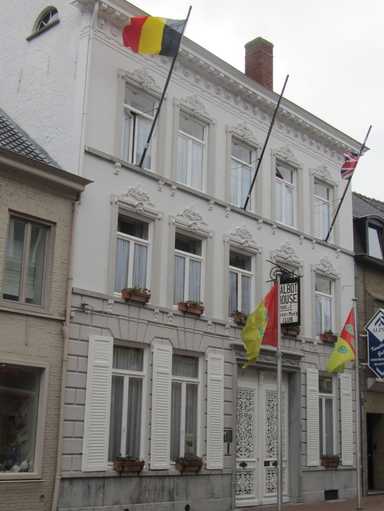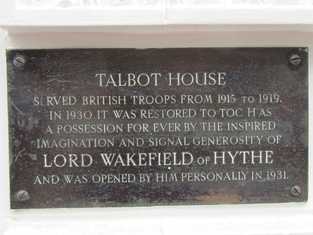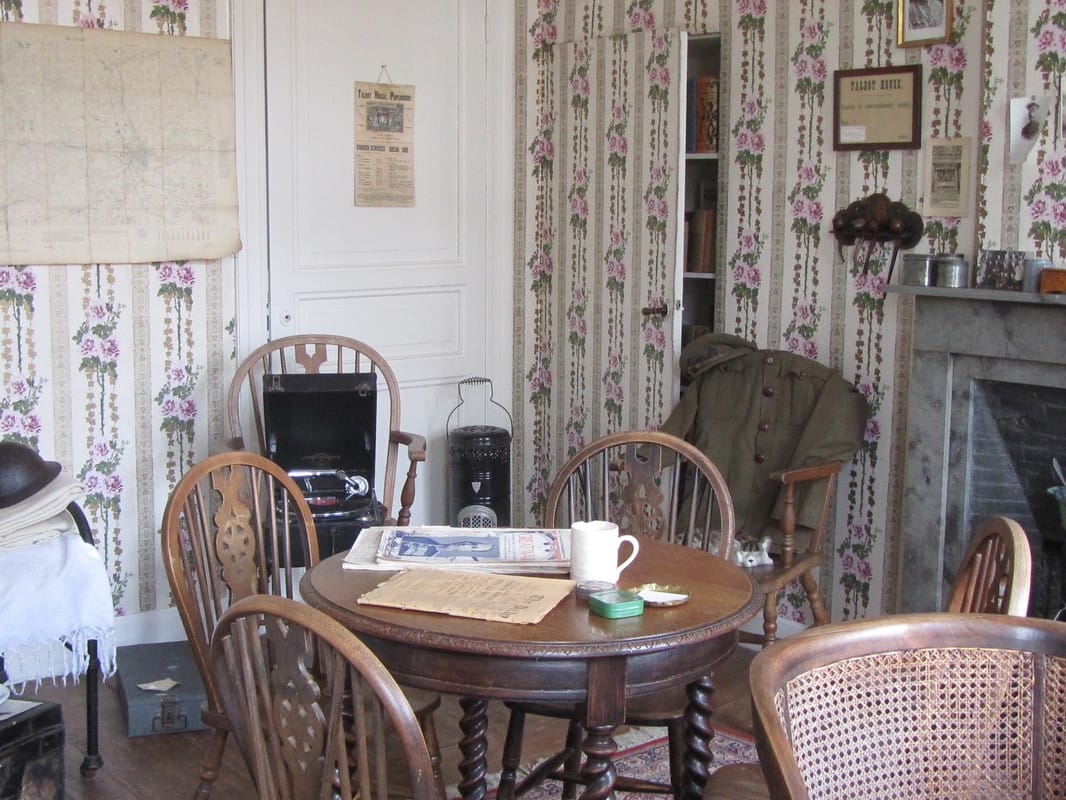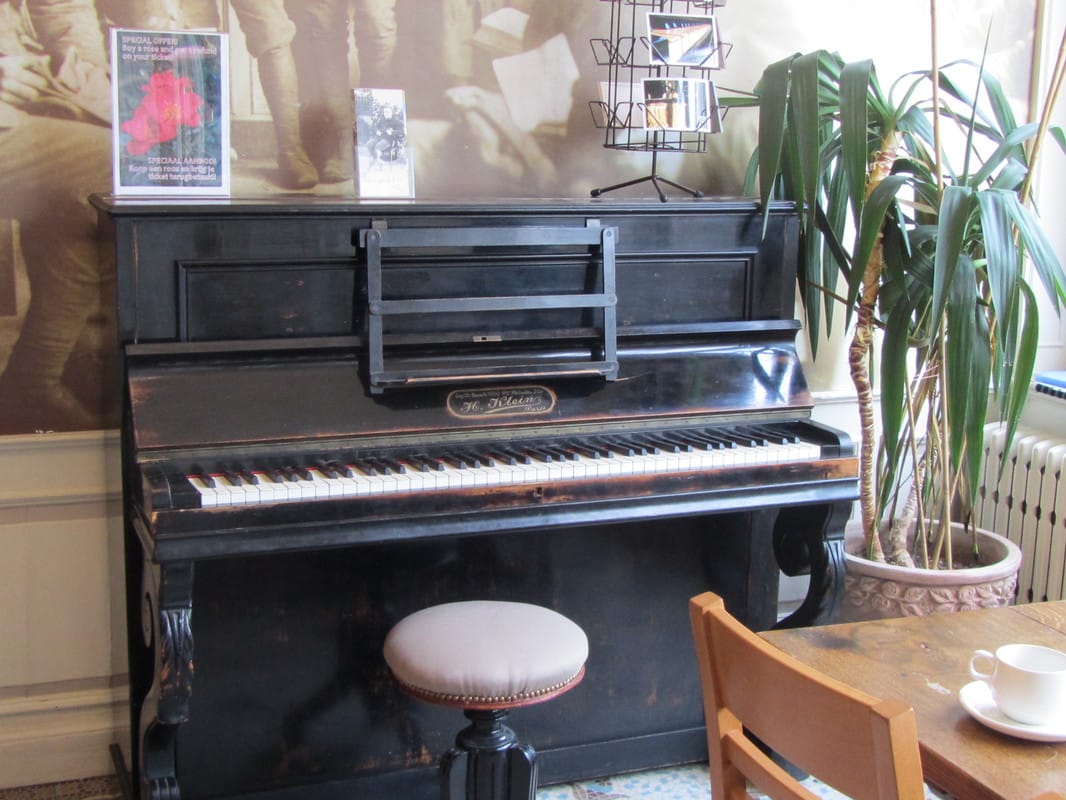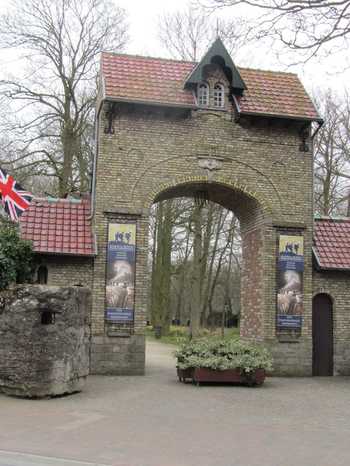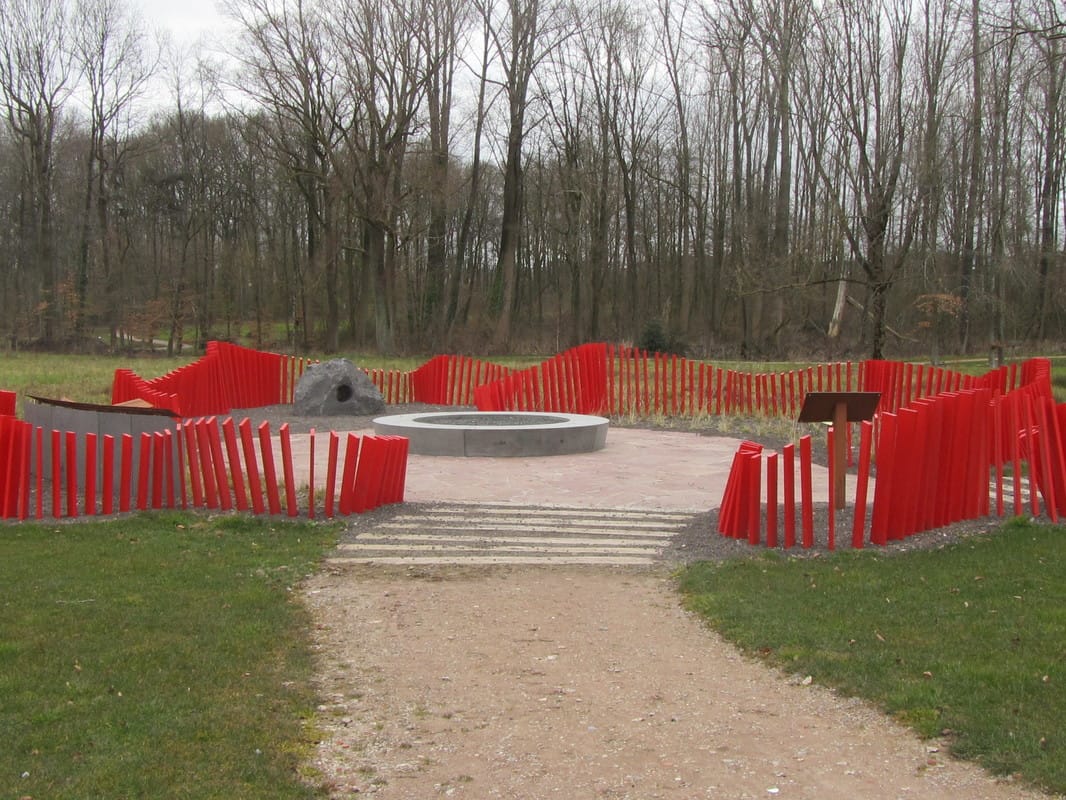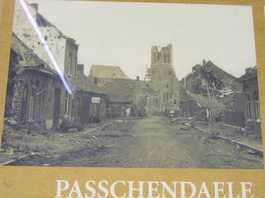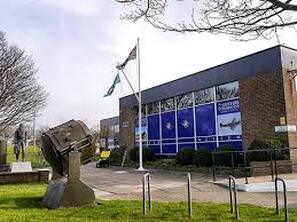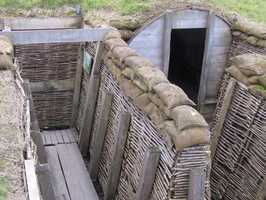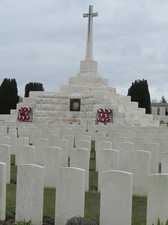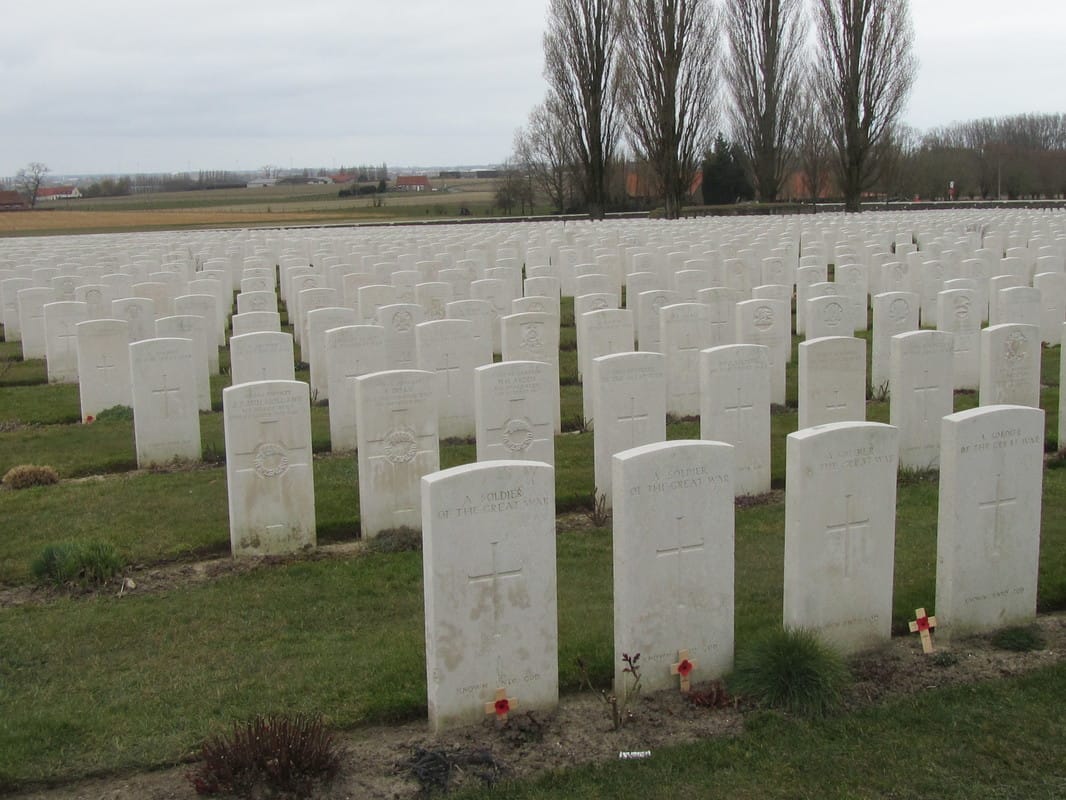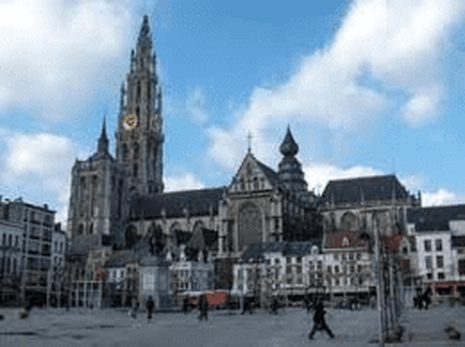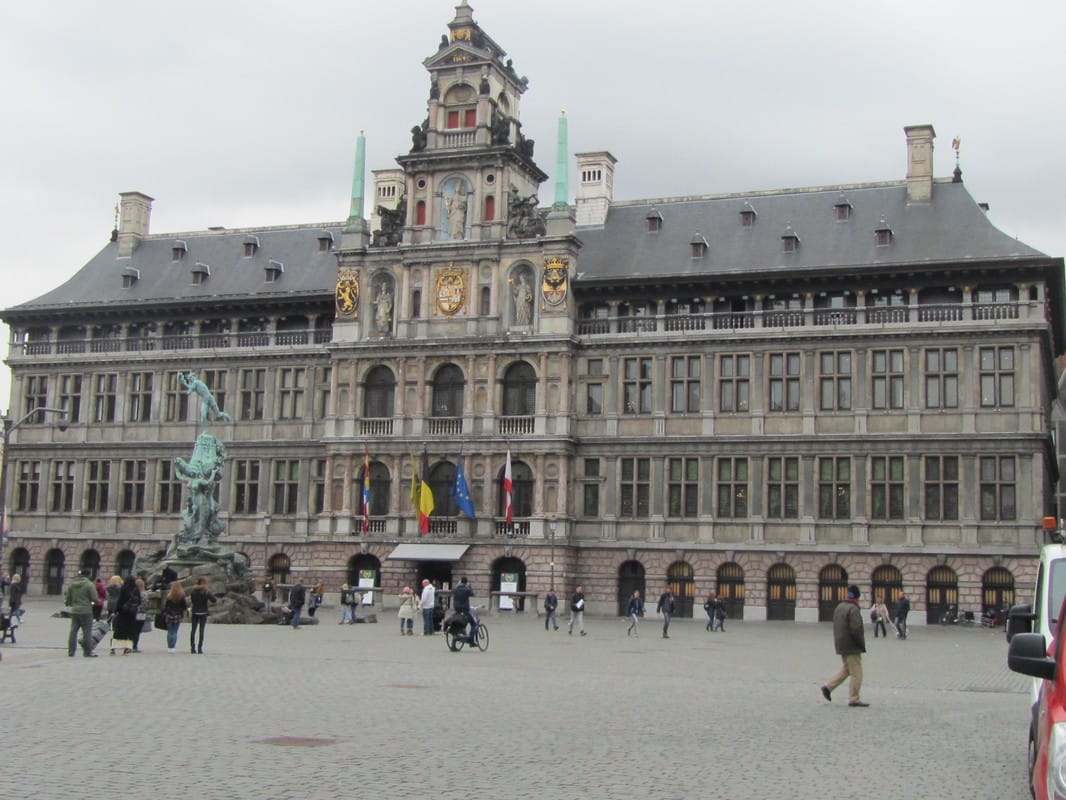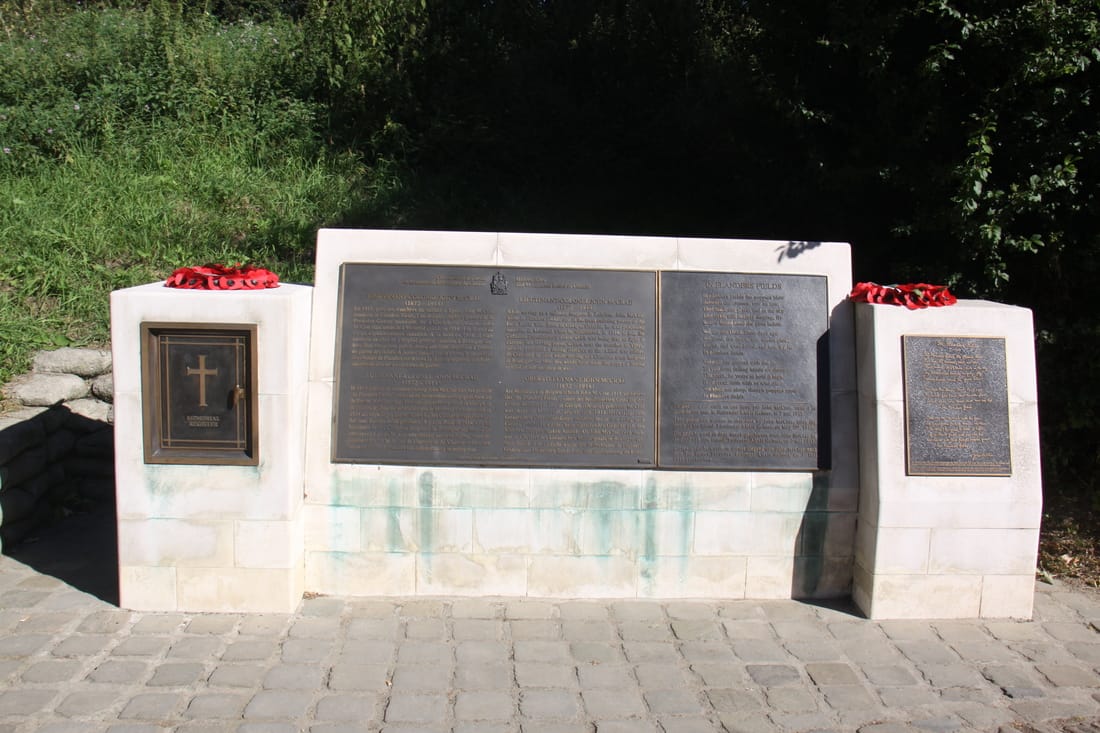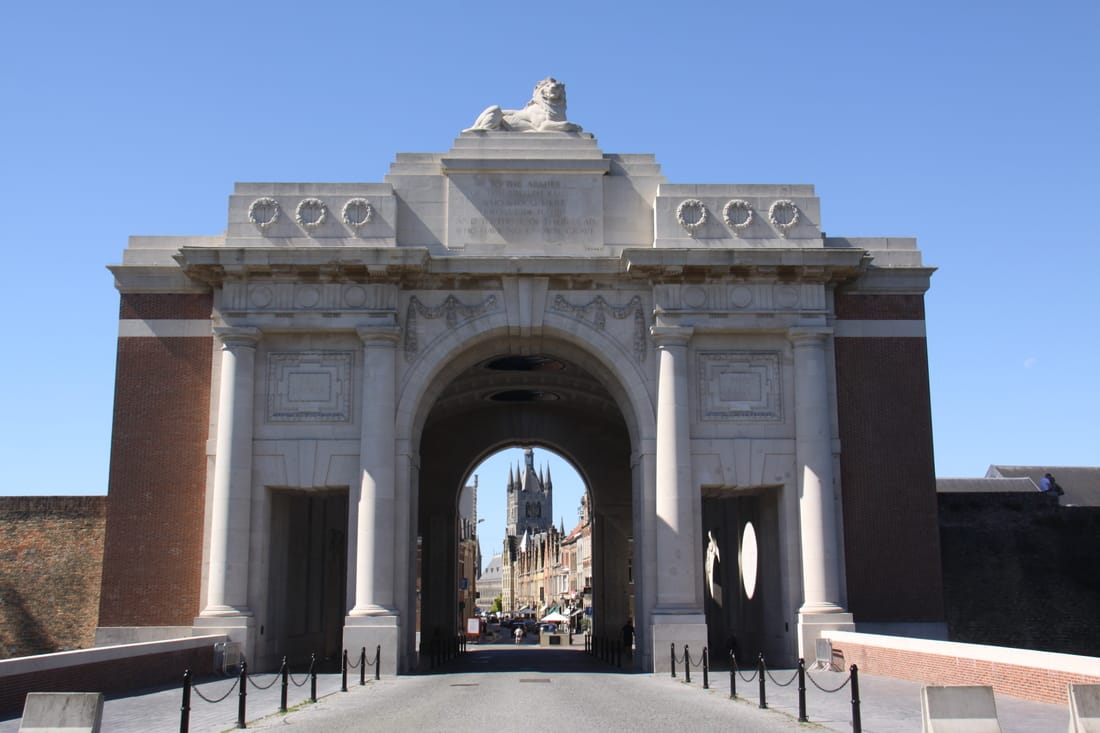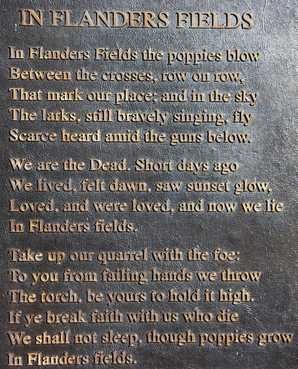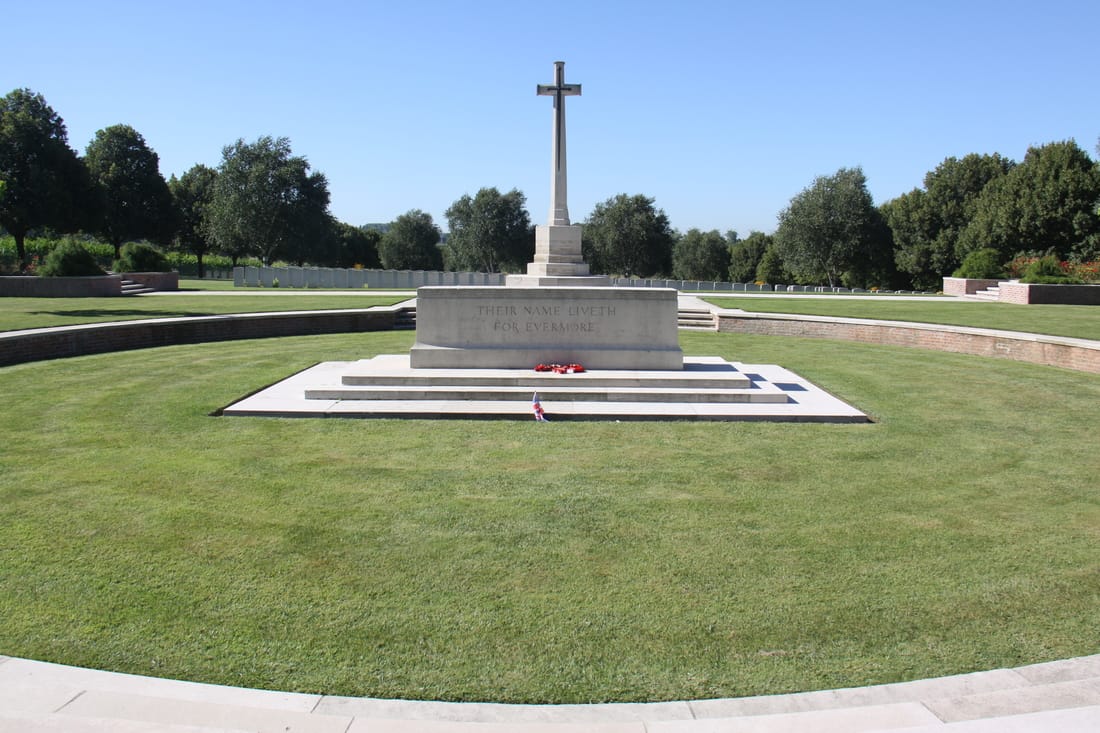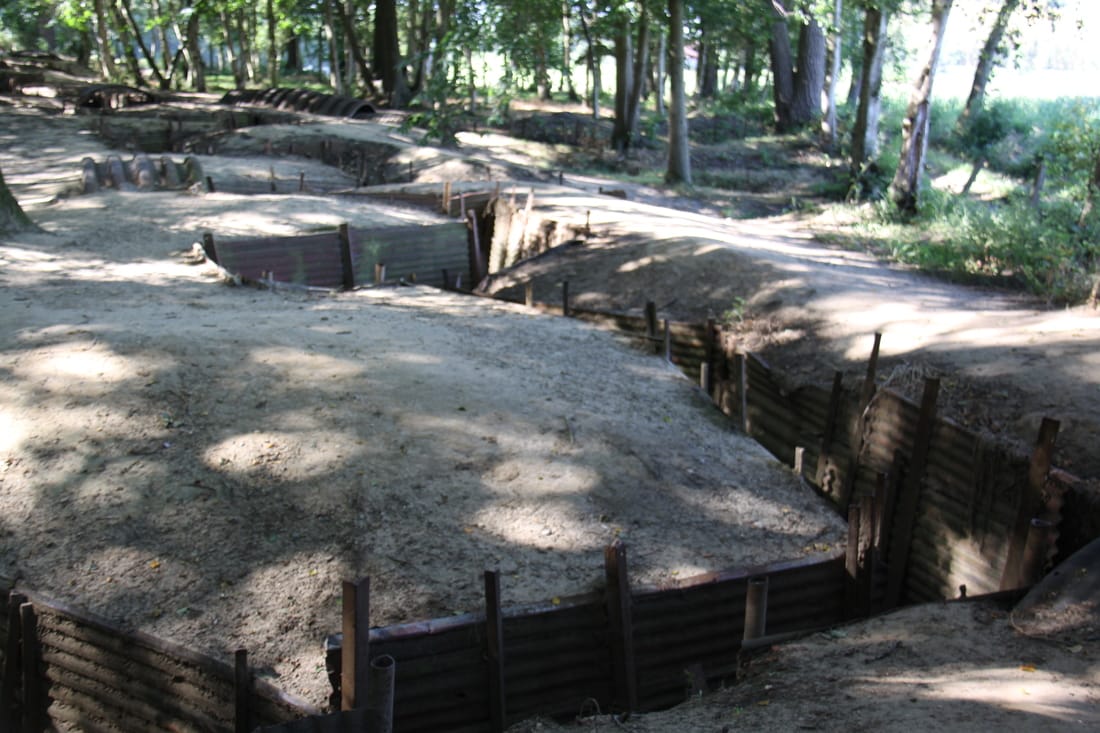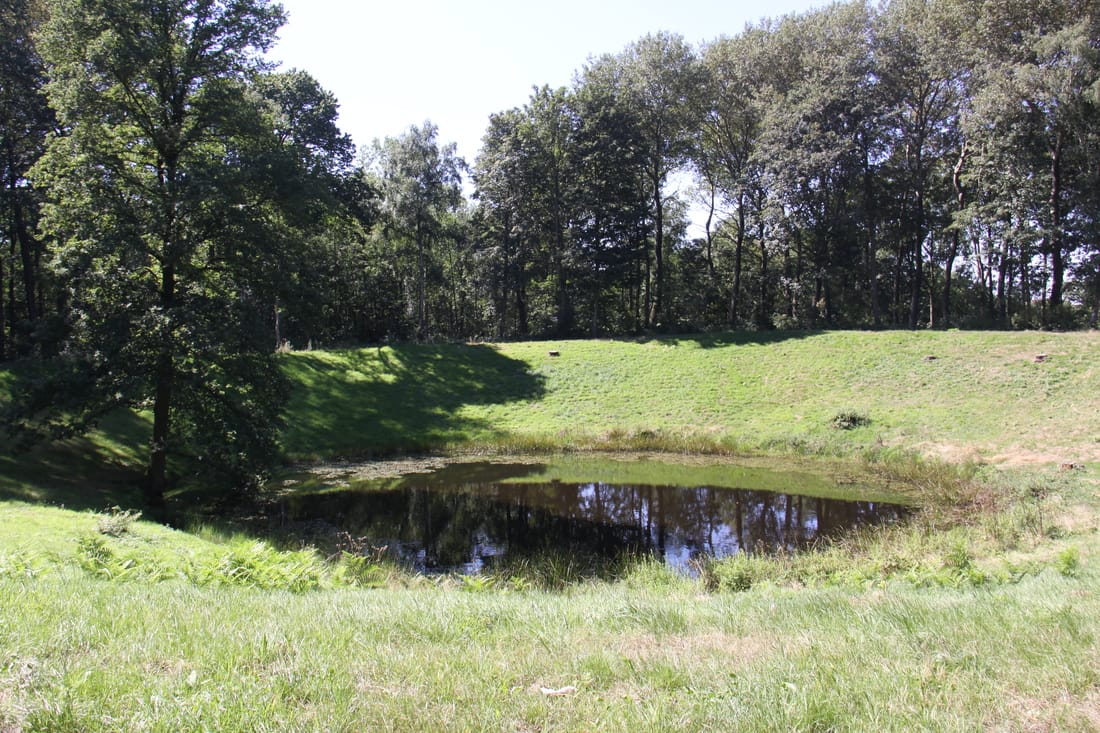World War I Memorial Sites in the Ypres Salient
Whilst delivering Nicolle to the docks in Antwerp in March 2016, en route for our trip to USA and Canada, we decided to take the opportunity to revisit some of the World War I sites in the Ypres Salient. It was many years since we were last there.

Friday 18th March
A good drive down to Dover. Quite a few coach parties on ferry, mainly school groups, but otherwise quiet. Overnight on the aire de camping at Camping Municipal le Beausejour, Arques. Free as the campsite was closed-according to their website it should have been open!
Saturday 19th March
A cold morning so a lazy start and once we were a little warmer, we set off to visit some of the World War I memorial sites in the Ypres salient which saw some of the fiercest fighting of the war. Many years ago we had visited Ypres with its fascinating "In Flanders Field" museum, the poignant Menin Gate, Hill 62 with its Canadian Memorial and finally Sanctuary Wood Museum with its well preserved trenches.
Our first visit today was to Talbot House in the small Belgian town of Poperinge. In 1915 an army chaplain, "Tubby" Clayton and Neville Talbot opened a club house for soldiers in memory of Neville's younger brother Gilbert who was killed in early 1915. The club was visited by soldiers for rest and recreation. The house and chapel in the eaves have been left untouched since 1918. Today the house and beautiful garden remain an oasis of peace.
A good drive down to Dover. Quite a few coach parties on ferry, mainly school groups, but otherwise quiet. Overnight on the aire de camping at Camping Municipal le Beausejour, Arques. Free as the campsite was closed-according to their website it should have been open!
Saturday 19th March
A cold morning so a lazy start and once we were a little warmer, we set off to visit some of the World War I memorial sites in the Ypres salient which saw some of the fiercest fighting of the war. Many years ago we had visited Ypres with its fascinating "In Flanders Field" museum, the poignant Menin Gate, Hill 62 with its Canadian Memorial and finally Sanctuary Wood Museum with its well preserved trenches.
Our first visit today was to Talbot House in the small Belgian town of Poperinge. In 1915 an army chaplain, "Tubby" Clayton and Neville Talbot opened a club house for soldiers in memory of Neville's younger brother Gilbert who was killed in early 1915. The club was visited by soldiers for rest and recreation. The house and chapel in the eaves have been left untouched since 1918. Today the house and beautiful garden remain an oasis of peace.

Some half an hour's drive from Poperinge lies the village of Zonnebeke, the home of the Memorial Museum Passchendaele 1917 and Tyne Cot Memorial and Cemetery. Today we spent exploring the memorial gardens, saving our visit t the actual museum for tomorrow. The memorial gardens are being developed a year at a time, so will necessitate a further visit in the future. These "Poppy Gardens" are dedicated to the various nations that fought in the Battle of Passchendaele. To date each "poppy shaped" garden is marked out by a line of red stakes in the shape of a poppy. Had a very good dinner in the restaurant and spent a quiet night on the large, level car park of the museum.
Some half an hour's drive from Poperinge lies the village of Zonnebeke, the home of the Memorial Museum Passchendaele 1917 and Tyne Cot Memorial and Cemetery. Today we spent exploring the memorial gardens, saving our visit t the actual museum for tomorrow. The memorial gardens are being developed a year at a time, so will necessitate a further visit in the future. These "Poppy Gardens" are dedicated to the various nations that fought in the Battle of Passchendaele. To date each "poppy shaped" garden is marked out by a line of red stakes in the shape of a poppy. Had a very good dinner in the restaurant and spent a quiet night on the large, level car park of the museum.
Sunday 20th March
We spent the morning exploring the Memorial Museum Passchendaele 1917. This museum is designed to explain the historical context of events leading up to the Battle of Passchendaele. The conditions under which the battle was fought and the huge loss of life as a result of the fighting makes this battle one of the most horrific of the war - all for the gain of eight kilometre of territory. The futilities of war.
The museum is divided into various sections including a film to give a general overview of the battles; interactive elements; a dug-out where you see how the British went to live underground in 1917 and finally sections of reconstructed German and British trenches.
Before heading to Antwerp for the night, we visited Tyne Cot Cemetery. With nearly 12,000 graves it is one of the largest Commonwealth cemeteries in the world. Only 3,800 of the bodies buried there could be identified. The rows of white headstones and the wall behind the cemetery where the names of 35,000 soldiers with no known grave are listed made a sobering end to our short exploration of some of the WWI sites in Flanders.
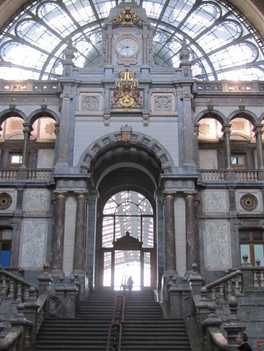
Overnight at Camping Vogelzang, Antwerp €8.50
Monday 21st March
Packed everything away and covered the inside of the van with dust sheets. We then visited the truck wash were we met Mary and Bernard with Hymie Hymer. They are on their way to Baltimore for a twelve month tour of North America.
On reaching the dock area we registered at the customs area to complete the relevant paperwork before heading to the docks where we were instructed to park the motorhome ready for it to be loaded on board on Friday. We shared a taxi with Mary and Bernard for the long ride back to central Antwerp.
We spent some time exploring the historic old city around the Grote Markt and Cathedral. There were many fine old houses but most were in need of restoration. None of them had plaques describing their historical importance.
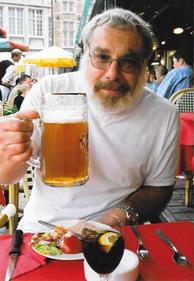
From the Grote Markt we walked to the Central Station, a magnificent ornate station with platforms at many different levels. Finding the correct one for our train in the morning could be quite a challenge.
Overnight at the IbisBudget Hotel next to the station.
Tuesday 22nd March
After an early breakfast we got to the station in time to take the earlier, slow train to Brussels. Arrived Brussels Station at 9.02, just as the security services were starting to evacuate the station, following the terrorist attacks at the airport and underground.
We managed to get an hotel room, many were not so lucky. Eurostar services suspended, no public transport and Brussels was in lock down. Police were advising people to stay off the streets.
Spent the day catching up on emails and text messages, doing puzzles, reading, watching TV and listening to music.
Wednesday 23rd March
Having rebooked our Eurostar ticket, we headed to the station early, met our son Jonny for coffee at St Pancras Station, his office in the city is very close and arrived home early afternoon.
Sue decided she wanted to spend more time visiting the World War I Memorial Sites on our return home, after having collected Nicolle from the docks in Antwerp at the end of our North America trip.
Monday 22nd August
We took an early morning train to Kings Cross from where we transferred across to St. Pancras to catch the mid-day Euro Star to Brussels - not a very comfortable ride. John had hurt his knee whilst walking to the station this morning and there wasn't enough leg room for him to stretch out. On reaching Brussels we made a bad choice by catching the first train to Antwerp - it was very slow stopping at every halt/station on route. When eventually reaching Antwerp we quickly found our hotel for the night.
Tuesday 23rd August
We had to report to the shipping agents office by 8.30am. We had booked the taxi the night before so there was no waiting around. Formalities were soon over and we were driven to the correct dock, a much easier journey than when we had delivered Nicolle to the docks and got lost in the maze of dock approach roads. The agent handled all the paper work and waited while we checked Nicolle.
By 10am we were on the road and as the dock this time was to the west of the Scheldt, we were soon on our way and didn't have to negotiate any of the Antwerp ring road.
We stopped at a motorhome dealership to fill up with water. This turned out to be a poor choice as the water had a pungent smell! We made sure we only drank bottled water until we reached home.
We drove to Ypres and headed to the Passchendaele Museum site car park at Zonnebeke for the night. We had planned on eating at the museum restaurant but unfortunately it was closed on a Tuesday. So instead we had a salad in a restaurant close by. John enjoyed his beer!
It was hot and humid so we decided to have only a short stroll of the grounds of the museum before we settled for the night.
Wednesday 24th August
We woke to a lovely bright morning just right for our visit to many of the World War I sites in the area. John's knee was still troubling him so he left me to wander round taking the photographs.
Our first visit of the day was to Tyne Cot cemetery - when we were there in the spring the weather had been very overcast. Today conditions were perfect for taking photos.
We next headed into Ypres town centre and after getting a little lost following signs to "centrum", we eventually arrived at the Grote Markt and were amazed to find that you could park here for a very reasonable charge, indeed the first hour was free!
We bought a driving tour guide book for the Ypres Salient and this proved to be very useful.
In Ypres we had a quick look in the cathedral before heading for St. George's Memorial Church. This church was built to honour the soldiers and units who had served in the Ypres Salient. The interior of the Church was simple. Every item from the windows and the chairs to the banners and plaques on the wall are in memory of a person who gave their life for freedom.
Our exploration of Ypres concluded with a visit to the Menin Gate - here the names of the missing are engraved so that even those with no known grave are not forgotten.
Essex Farm on the northern outskirts of the town is the place where John McCrae, a military doctor, wrote the well known words to the famous war poem, In Flanders Fields. Here there is a memorial to John McCrae, a small cemetery and the remains of an advanced field dressing station. The inside was a maze of small rooms - very claustrophobic.
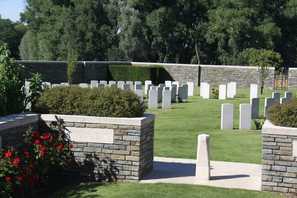
We ended the day with a visit to Polygon Wood Cemetery and memorial. This cemetery was close to the woods so was extremely peaceful.
We returned to the car park at Zonnebeke for the night.
Thursday 25th August
We started the day with a visit to the Hooge Crater Museum. This museum, although small and rather compact, was well set out and had an interesting film with some original footage, of the battles that had taken place in the vicinity. Life size exhibits were very well presented and there was an amazing collection of both British and German ammunition.
The cemetery was located across a very busy road - John stayed behind as he still didn't feel up to dodging around fast moving traffic. The Cross of Sacrifice is surrounded by a white stone faced circle which serves as a reminder of the many craters in the area.
We started the day with a visit to the Hooge Crater Museum. This museum, although small and rather compact, was well set out and had an interesting film with some original footage, of the battles that had taken place in the vicinity. Life size exhibits were very well presented and there was an amazing collection of both British and German ammunition.
The cemetery was located across a very busy road - John stayed behind as he still didn't feel up to dodging around fast moving traffic. The Cross of Sacrifice is surrounded by a white stone faced circle which serves as a reminder of the many craters in the area.
We drove out to visit Spanbrockmolen Crater, "Pool of Peace", which turned out rather difficult to find as it was located down a maze of narrow country lanes. Today it is a beautiful, peaceful spot with no indication of the destruction of WWI and the simultaneous blowing up of the mines in underground tunnels that caused the crater.
From here we headed to the Sanctuary Wood Museum at Hill 62. This distinctly quirky museum was crammed full of dusty, jumbled memorabilia of 100 years ago. The main draw was the unique collection of 3D picture boxes showing stereoscope photos actually taken during the war. Behind the museum building are the remains of an original section of trenches built by the Canadians to aid the ridge of slightly higher ground around Ypres. Complete with dug outs and underground passages, bomb craters and scarred trees this all felt authentic.
We ended the day by visiting Hill 60. Here there are many craters , one of which is now filled with water - "Caterpillar Crater". Lines on the ground mark no fewer than seven front lines!
It had been another hot day so we ended our visit to the Ypres Salient by visiting the small, but interesting exhibition back in Zonnebeke - entitled, "Building the Front".
Friday 26th August
Today we headed to Arques in France in order to do the hypermarket shopping at the Auchan in St. Omer.
Overnight in the aire by the lake at Camping Municipal le Beausejour, Arques.
Saturday 27th August
Early departure to get a morning ferry from Calais. The port was very busy and we were able to travel on an earlier ferry - a bonus as that ferry should have cost us more than the one we had booked.
Home by early afternoon.
[click] to return to Home page
